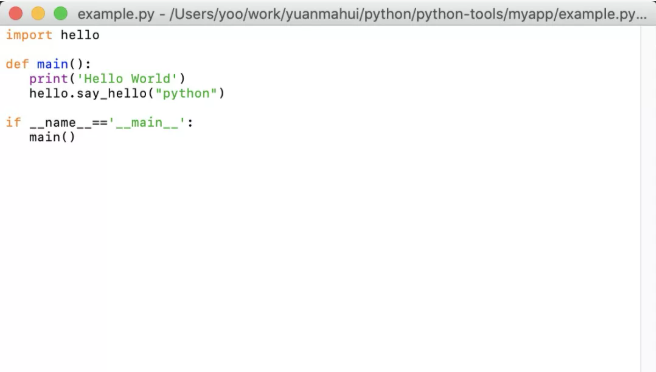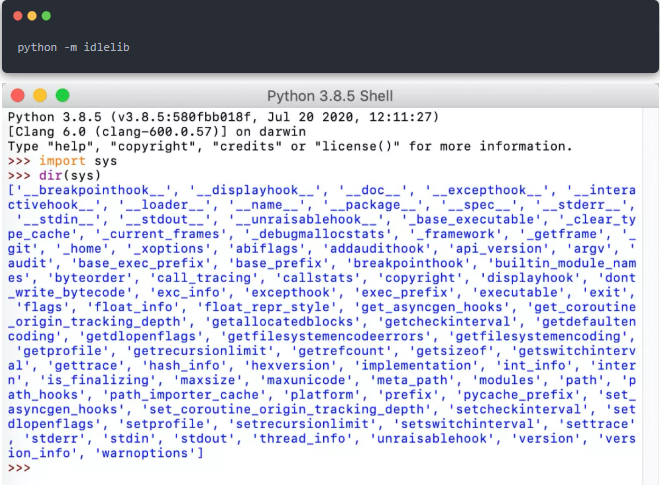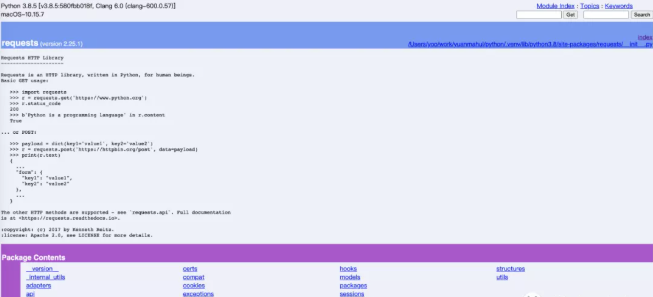Python comes with some command-line tools that can be used to quickly process work. I call these command-line tools cold weapons. They can be used instead when they are not available. These tools are Python standard modules with main function, which can be executed directly with python -m command. Most of them can use - H / - help to view help.
1. http service
Start an http static file service
# python -m http.server Serving HTTP on :: port 8000 (http://[::]:8000/) ...
2. json formatting
Formatting json data
# echo '{"amount":3.4}' | python -m json.tool
{
"amount": 3.4
}3. Visual editor and shell
The idlelib module is based on tkinter and can be used as an editor and shell. File editor effects.
python -m idlelib myapp/example.py

shell effect
python -m idlelib
gui-shell

4. python application packaging
Build myapp directory as follows:
├── myapp │ ├── example.py │ └── hello.py
The codes are as follows:
# example.py
import hello
def main():
print('Hello World')
hello.say_hello("python")
if __name__=='__main__':
main()
# hello.py
def say_hello(name):
print("hello",name)Package the whole myapp into an application. After the command is executed, a new one named myapp will be generated Pyz application.
python -m zipapp myapp -m "example:main"
Running applications directly using python
# python myapp.pyz Hello World hello python
5. ROT13 encryption
Rot13 (rotate by 13 places) is a simple substitution cipher, which is a variant of Caesar's cipher. Rot13 offsets the original text by 13 bits to form a ciphertext. Because English has a total of 26 bits, the ciphertext will return to the original text after offsetting another 13 bits. Formula: rot13(rot13(xxx))=xxx.
# echo "xxx" | python -m encodings.rot_13 Tvir zr n fgne
As a small colored egg, you are welcome to decipher the value of xxx
6. base64 coding
base64 encodes a string
# echo "haha" | python -m base64 aGFoYQo= # echo "aGFoYQo=" | python -m base64 -d haha
base64 also supports encoding files. Write test code
# sample.py
def main():
print('Hello World👌')
if __name__=='__main__':
main()Compile the code into a base64 string
# python -m base64 sample.py CmRlZiBtYWluKCk6CiAgIHByaW50KCdIZWxsbyBXb3JsZPCfkYwnKQogICAKaWYgX19uYW1lX189 PSdfX21haW5fXyc6CiAgIG1haW4oKQo=
Execute compiled code
# echo "CmRlZiBtYWluKCk6CiAgIHByaW50KCdIZWxsbyBXb3JsZPCfkYwnKQogICAKaWYgX19uYW1lX189 PSdfX21haW5fXyc6CiAgIG1haW4oKQo=" | python -m base64 -d | python Hello World👌
Similarly, UU (UNIX to UNIX encoding) can be used to encode the code:
# python -m uu sample.py
begin 644 sample.py
M"F1E9B!M86EN*"DZ"B @('!R:6YT*"=(96QL;R!7;W)L9/"?D8PG*0H@(" *
C:68@7U]N86UE7U\]/2=?7VUA:6Y?7R<Z"B @(&UA:6XH*0H
endUse quopri (encode and decode mime quoted printable data) to encode the code:
# python -m quopri -t sample.py
def=20main():
=20=20=20print('Hello=20World=F0=9F=91=8C')
=20=20=20
if=20__name__=3D=3D'__main__':
=20=20=20main()7. mime identification
Identify the mime type of the file or url
# python -m mimetypes https://docs.python.org/3/library/mimetypes.html type: text/html encoding: None # html # python -m mimetypes https://www.google.com/images/branding/googlelogo/2x/googlelogo_color_272x92dp.png type: image/png encoding: None # png # python -m mimetypes sample.py type: text/x-python encoding: None #python files # python -m mimetypes sample.py.gz type: text/x-python encoding: gzip #python files, gzip compression
8. View python environment information
python -m sysconfig Platform: "macosx-10.9-x86_64" Python version: "3.8" Current installation scheme: "posix_prefix" Paths: data = "/Users/yoo/work/yuanmahui/python/.venv" include = "/Library/Frameworks/Python.framework/Versions/3.8/include/python3.8" ... Variables: ... PYTHON = "python" PYTHONFRAMEWORK = "Python" PYTHONFRAMEWORKDIR = "Python.framework" PYTHONFRAMEWORKINSTALLDIR = "/Library/Frameworks/Python.framework" ...
You can also view the system path using the following command
# python -m site sys.path = [ '/Users/yoo/work/yuanmahui/python/python-tools', '/Library/Frameworks/Python.framework/Versions/3.8/lib/python38.zip', '/Library/Frameworks/Python.framework/Versions/3.8/lib/python3.8', '/Library/Frameworks/Python.framework/Versions/3.8/lib/python3.8/lib-dynload', '/Users/yoo/work/yuanmahui/python/.venv/lib/python3.8/site-packages', ] USER_BASE: '/Users/yoo/Library/Python/3.8' (exists) USER_SITE: '/Users/yoo/Library/Python/3.8/lib/python/site-packages' (exists) ENABLE_USER_SITE: False
9. Compiling scripts
compileall can compile python scripts. There are two py scripts in the myapp directory
# ll myapp total 16 -rw-r--r-- 1 yoo staff 118B 2 26 23:03 example.py -rw-r--r-- 1 yoo staff 43B 2 26 23:03 hello.py
Compile script
# python -m compileall myapp Listing 'myapp'... Compiling 'myapp/example.py'... Compiling 'myapp/hello.py'...
View compilation results
tree myapp -L 3 myapp ├── __pycache__ │ ├── example.cpython-38.pyc │ └── hello.cpython-38.pyc ├── example.py └── hello.py 1 directory, 4 files
10. Compression and decompression
Create and unzip the tar package
# python -m tarfile -c myapp.tar myapp #Create myapp Tar compressed package # python -m tarfile -e myapp.tar myapp2 #Unzip myapp Tar # to myapp2 directory
Compress files using gzip
# python -m gizp sample.py # python -m gzip -d sample.py.gz
Package files using zip
# python -m zipfile -c myapp.zip myapp # python -m zipfile -e myapp.zip myapp2
Note: zipfile is different from zipapp, and then an executable app is generated
11. telnet tools
In python containers without telnet tools, you can do this:
# python -m telnetlib -d redis 6379 #Connect to redis monitor Telnet(redis,6379): send b'monitor\n' Telnet(redis,6379): recv b'-NOAUTH Authentication required.\r\n' -NOAUTH Authentication required.
There are also two tools, nntplib & & ftplib, which should be rarely used. I won't introduce them
12. Performance and commissioning tools
The built-in timeit can test the performance data of the script
# python -m timeit '"-".join([str(n) for n in range(100) if n%2 == 0])' #Modulo even 20000 loops, best of 5: 12.5 usec per loop # python -m timeit '"-".join([str(n) for n in range(0,100,2)])' #Step 50000 loops, best of 5: 8.85 usec per loop # python -m timeit '"-".join([str(n) for n in range(100) if n&1 == 0])' #Bit operation judgment parity 20000 loops, best of 5: 14.3 usec per loop
Unscientific 1: bit operation is slower than modulo?
If it is not a string but a script:
def test_normal(): tmp = "" for x in range(100): if x % 2 == 0: if tmp: tmp = tmp+"-"+str(x) else: tmp = str(x) return tmp if __name__ == '__main__': print(test_normal())
It can be used flexibly in the following ways
# python -m base64 test_string_join.py | python -m base64 -d | python -m timeit 50000000 loops, best of 5: 5.33 nsec per loop
Unscientific 2: 50 million cycles require only 5.33 nanoseconds, while the previous use case 20000 cycles require 12.5 microseconds
There are PDB & & profile & & pstats in the standard library, which is complex to use, so I won't introduce it for the time being
pypy3 -m timeit '[{} for n in range(1000)]'
WARNING: timeit is a very unreliable tool. use pyperf or something else for real measurements
pypy3 -m pip install pyperf
pypy3 -m pyperf timeit '[{} for n in range(1000)]'
------------------------------------------------------------
100000 loops, average of 7: 7.3 +- 0.107 usec per loop (using standard deviation)
[tywork@liujunhong_szfsfz_work1 config]$ pypy3 -m pyperf timeit '[{} for n in range(1000)]'
........
Mean +- std dev: 8.42 us +- 0.25 us
[tywork@liujunhong_szfsfz_work1 config]$
[tywork@liujunhong_szfsfz_work1 config]$
[tywork@liujunhong_szfsfz_work1 config]$
[tywork@liujunhong_szfsfz_work1 config]$ pypy3 -m pyperf timeit '[dict() for n in range(1000)]'
.........
Mean +- std dev: 29.6 us +- 1.1 us13. pydoc
Viewing python code documents in local service mode
# python -m pydoc -p 8080 #Start a web service Server ready at http://localhost:8080/ Server commands: [b]rowser, [q]uit server> b
The document effect is shown in the figure below

14. test
Execute the test cases provided with python to see which features the system supports
# python -m test.regrtest -u cpu == CPython 2.7.16 (default, Jun 5 2020, 22:59:21) [GCC 4.2.1 Compatible Apple LLVM 11.0.3 (clang-1103.0.29.20) (-macos10.15-objc- == Darwin-19.6.0-x86_64-i386-64bit little-endian == /private/var/folders/mv/3vgd3mdx2453clfcst7qlm280000gn/T/test_python_13470 == CPU count: 12 Run tests sequentially 0:00:00 load avg: 2.53 [ 1/404] test_grammar ... = Tests result: FAILURE == 363 tests OK. 5 tests failed: test_import test_posix test_py_compile test_rlcompleter test_scriptpackages 36 tests skipped: test_al test_bsddb test_bsddb3 test_cd test_cl test_codecmaps_cn test_codecmaps_hk test_codecmaps_jp test_codecmaps_kr test_codecmaps_tw test_curses test_epoll test_gdb test_gdbm test_gl test_imgfile test_largefile test_linuxaudiodev test_msilib test_ossaudiodev test_poll test_py3kwarn test_smtpnet test_socketserver test_spwd test_startfile test_sunaudiodev test_timeout test_tk test_tools test_ttk_guionly test_urllib2net test_urllibnet test_winreg test_winsound test_zipfile64 2 skips unexpected on darwin: test_spwd test_tools Total duration: 5 min 23 sec Tests result: FAILURE
From the test cases, we can see that osx supports fork and does not support epool and poll.
0:00:47 load avg: 1.79 [138/404] test_fork1 ... 0:00:39 load avg: 1.59 [125/404] test_epoll test_epoll skipped -- test works only on Linux 2.6 ... 0:02:42 load avg: 2.41 [257/404/1] test_poll test_poll skipped -- select.poll not defined -- skipping test_poll 0:02:42 load avg: 2.41 [258/404/1] test_popen -- test_poll skipped